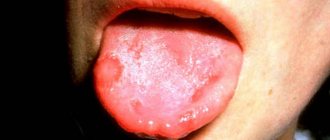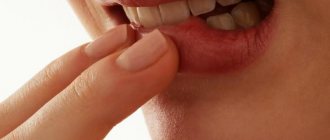Causes of the problem
A red spot on the tongue can be a manifestation of a variety of pathologies, for example:
- Vitamin deficiency
Redness of the tongue is caused by a deficiency of B vitamins and niacin.
- Allergy
Response to food, drinks, drugs
- The burn is
not only thermal, but also chemical. The Internet is full of different, sometimes strange, advice. Experimenting on yourself can have sad consequences.
- Hormonal imbalance
Red spots on the tongue often appear in women during pregnancy and menopause.
- Infections of various etiologies
Bacteria and viruses provoke inflammatory processes, one of the symptoms of which is discoloration.
Red spots on the tongue are not yet a diagnosis. A doctor needs to conduct an examination to determine the exact cause.
Redness of the tongue may indicate various diseases.
Types of pathology
If red spots in the mouth are associated specifically with a violation of the condition of the mucous membrane of the tongue, then there are several types of glossitis:
- catarrhal
(acute). Appears due to mechanical trauma to tissue (food, dentures, edges of teeth, etc.). May be a symptom of allergies, ARVI. Accompanied by increased salivation, swelling of the tongue, red dots on its root. - desquamative
. Due to the detachment of the upper layer of tongue tissue, red spots appear. This glossitis is called geographic, exfoliative. Due to improper metabolism in the epithelial cells, in some places they harden and peel off, the old membrane comes off unevenly and resembles a map pattern. Some patients do not notice anything for a long time, only sensitivity to sour foods and foods flavored with spices. Causes of desquamative type: problems with the gastrointestinal tract, endocrine system and metabolism.
diamond -shaped A red, diamond-shaped spot on the tongue is a sign of a gastrointestinal disorder, candidiasis.- atrophic
is expressed in atrophy of the papillae, they turn into bright red spots located close to each other or concentrated in one part. - black
(“hairy” tongue) is one of the types of desquamative glossitis, more precisely, its stage when everything has already peeled off or stopped, the papillae are exposed and enlarged. They change color and become dark due to reactions upon contact with food and intraoral microflora. Often the condition is accompanied by a burning sensation and the sensation of a foreign body in the mouth, and gagging. - folded
glossitis is considered congenital. In a child it is less pronounced, and in adolescence the folds are more distinct. With poor oral hygiene, food debris and bacteria can accumulate in them, and candidiasis can develop, which leads to another type - desquamative.
Red spots on the tongue may indicate the following diseases in the body:
- stomatitis. The disease of “dirty hands” or the body’s immune response, the exact mechanism of triggering the disease is still not known. Aphthae, the formation of ulcers against the background of red spots on the mucous membrane, including the tongue, bothers a person. Sometimes it is enough to pay more attention to hygiene to prevent the formation of new aphthae.
- scarlet fever
. Rashes on the mucous membrane, redness of the tongue (turns crimson), fever, sore throat are symptoms of this infectious disease. Children get sick more often. But it can pass from a child to an adult. - erythema
. Red spots can turn into bubbles with liquid, which burst after a while, leaving ulcers and erosions in their place. They hurt and interfere with eating and speaking. - mononucleosis
. A viral disease determined by changes in blood composition. Multiple hemorrhages on the surface of the tongue of a pinpoint nature may give reason to the doctor to write a referral for testing. - Kawasaki virus
- red rashes on the body (chest, back, arms, feet), bright red, crimson bumps on the tongue. - sexually transmitted diseases
(syphilis) affect the entire system; in the oral cavity, dense red spots can be noted on the tongue, which do not cause concern. - AIDS and HIV are often accompanied by Kaposi's sarcoma.
The spots at the root of the tongue are red. - anemia
- white tongue with red spots.
In fact, there are still many diseases where one of the signs is a change in the color of the tongue and the appearance of plaque, spots, and aphthae. Only a specialist can diagnose.
Work examples
How often do you visit the dentist?
Diagnosis
It is difficult to independently distinguish relatively harmless manifestations of diseases in the form of red spots from serious disorders. Any rash on the tongue already indicates systemic problems, but some of them indicate serious cases.
Erythroplakia requires immediate surgical intervention. Therefore, it is better not to take the position “it will go away on its own,” but to consult a doctor.
Since spots on the tongue are a symptom of disease, examination is usually aimed at identifying the causes. Laboratory tests, flora tests, histology and medical history allow us to make the correct diagnosis and prescribe appropriate treatment.
Associated symptoms for accurate diagnosis
In some cases, a strange reddish spot appears on the tongue, but the person does not experience any associated symptoms. In such a situation, the doctor will need to carry out additional diagnostic procedures to identify the causes of the defect. However, most often “spotting” is accompanied by other characteristic symptoms:
- soreness,
- discomfort while eating,
- numbness of the organ,
- burning sensation,
- the appearance of purulent ulcers,
- bad breath,
- spots on other areas of the mucous membrane,
- the formation of a dense plaque directly on the organ.
Pain, burning, numbness of the tongue may be a symptom of the disease.
Other accompanying symptoms include a general deterioration in condition, loss of strength, increased temperature - all this may indicate the rapid spread of infection in the body. But nausea, bloating, heartburn, and digestive problems most often result from problems in the gastrointestinal tract.
Disease prevention
Dental measures include:
- Regular thorough oral care.
A properly selected toothbrush, constant flossing, and rinsing your mouth after eating will help avoid inflammatory processes.
- Use a toothpaste that suits the purpose at this stage. You cannot use whitening or medicinal pastes constantly, only in courses.
General preventive measures:
- Healthy lifestyle
- To give up smoking
- Regular medical examinations
Preventive measures
To prevent any disease of the tongue, it is important to take the most responsible approach to oral hygiene, monitor the cleanliness of the organ, brush your teeth at least twice a day with a brush and toothpaste, and rinse your mouth every time after a meal. In addition to these basic rules, you must adhere to other important recommendations from experts:
- try to eliminate too spicy, salty, sour and sweet foods from your diet, eat more vegetables and fruits,
- give up bad habits, such as smoking and uncontrolled drinking,
- periodically take multivitamin complexes to strengthen the immune system,
- spend more time in the fresh air, lead a physically active lifestyle,
- systematically visit the dentist for routine examinations.
When you find strange burgundy or light pink spots on the surface of your tongue, the main thing is not to panic. There are a great many reasons for this phenomenon, and to make an accurate diagnosis, you definitely cannot do without an examination by a specialist. If you notice any new growths on an organ, even if they do not hurt or cause discomfort, be sure to make an appointment with a doctor.
- Kargaltseva, N. M. The oral cavity is an important biotope of the human body, 2001.
Expert opinion
Roman Borisovich Alekperov
orthopedic dentist
Experience: 24 years
Most often, red spots on the tongue are not accompanied by pain. A slight burning sensation or no symptoms at all creates a dangerous feeling that the problem will go away on its own. This can worsen the condition and cause serious consequences. If you have red spots on your tongue, consult a doctor. It is better to quickly take measures recommended by professionals than to spend a long time on treatment later.
Treatment
Treatment of red spots on the tongue involves eliminating the provoking factor. If you have bad habits that caused the phenomenon in question, you need to give them up. It is important not to rub the red spots during treatment. This leads to the formation of open wounds on the surface of the tongue, which can lead to infection of the body.
Self-medication is dangerous with complications!
Attention
Despite the fact that our articles are based on trusted sources and have been tested by practicing doctors, the same symptoms can be signs of different diseases, and the disease may not proceed according to the textbook.
Pros of seeing a doctor:
- Only a specialist will prescribe suitable medications.
- Recovery will be easier and faster.
- The doctor will monitor the course of the disease and help avoid complications.
find a doctor
Do not try to treat yourself - consult a specialist.
Therapy for candidiasis involves taking antifungal drugs and immunomodulators. Additionally, vitamin complexes are prescribed and the oral cavity is treated with antiseptic substances.
If the tongue turns red due to an allergic reaction of the body, it is important to eliminate the influence of the provoking factor: stop taking medications, stop consuming certain foods.
Antihistamines are used to suppress the main symptoms. If necessary, therapy is supplemented with corticosteroids and vitamin complexes.
The treatment of herpes zoster uses a comprehensive approach, including the simultaneous use of antibacterial and antiviral drugs. To eliminate sarcoma, a consultation at the oncology center is necessary. Such a tumor is eliminated through chemotherapy.
If you suspect diseases of the gastrointestinal tract, it is recommended to adjust your diet by excluding spicy and smoked foods. In addition to these measures, the immune system should be strengthened.
If dense spots are detected on the surface of the tongue, the patient is sent for examination to a dermatovenerologist. If the latter confirms the presence of syphilis, appropriate therapy is carried out.
Stomatitis and other similar diseases can be cured through regular oral treatment prescribed by a dentist.
Where to contact
Any dentist will be able to help with advice, but it is still better to contact multidisciplinary clinics. The larger the clinic, the more patients, which means the doctors’ experience is much wider. In addition, high-quality specialists are rarely seen in modest dentistry on the outskirts of the city; they mostly work in large centers. Another reason to contact a multidisciplinary center is that they pay great attention to improving the qualifications of doctors, including in therapeutic dentistry.
The table shows contacts of 5 clinics where you will be advised about red spots on the tongue.
| Dental center | Clinic address | Working hours |
| ROOT | Moscow, st. Rustaveli, 14 building 9 8 800 775–26–37 | 10:00-22:00 seven days a week |
| Your smile.rf | Moscow, Palikha street, 10, building 9 8 | 9:00-21:00 seven days a week |
| Center Family Dentistry | Moscow, Orekhovy Boulevard, 59k2 8 | 9:00-21:00 seven days a week |
| Unident | Moscow, Bobrov lane, 4, building 1 8 | 9:00-21:00 seven days a week |
| CityDent | Moscow, st. Novocheremushkinskaya, 57 8 | 10:00-23:00 day off - Sunday |
How is therapy carried out?
Treatment of the symptom in question first requires identifying the source of the problem, that is, the primary cause. If the change in the condition of the tongue is the result of an injury or allergy, then the patient needs to reconsider his diet, eliminate the allergen and be more attentive to the condition of the oral cavity, try not to injure the mucous membrane with foreign objects.
If the culprit is a certain disruption in the functioning of the internal systems, then you cannot do without the help of a highly specialized doctor - a general practitioner or dentist, depending on who you contacted, will redirect you to a gastroenterologist, endocrinologist or immunologist.
An ultrasound will help determine the cause of the pain.
But for symptomatic treatment, it is advised to resort to traditional medicine. Many medicinal herbs have long been famous for their antiseptic, soothing and wound-healing properties. Just remember: the use of all kinds of infusions and decoctions for mouth rinsing is allowed only with the consent of the attending physician. Additionally, experts prescribe antifungal drugs, vitamin complexes and immunomodulators. If the tongue is very painful, painkillers must be prescribed.
What does this mean?
The appearance of red dots on the tongue can be caused by a number of reasons, including those that do not threaten health and life. However, in some cases, such rashes indicate the appearance of a specific disease.
Red dots can have different origins:
- wound, petechiae - slight hemorrhage (with a burn of the tongue, for example);
- telangiectasia, that is, spider veins;
- ulcer;
- erosion;
- epithelial tumor of malignant and benign nature;
- rashes (macula, papule, roseola).
That is why it is of great importance to seek medical help in the case when a person finds red dots on the root of the tongue, as well as on other parts of this organ, in his child or himself.
Features of changing the type of language
The whitish plaque in the form of dots that covers the surface of the tongue is formed due to the fact that the cells of the miniature papillae become rough and keratinized. This phenomenon is caused by:
- the presence of infection inside the body;
- problems with the digestive tract;
- taking pharmaceutical drugs;
- diseases .
If a person’s health is fine, the tongue has a faint pink tint. A small amount of plaque can be easily cleaned off. The papillae do not thicken. There is no specific smell.
The following conditions can contribute to the appearance of white spots on the tongue: infection of the body, disruption of the digestive tract, dental damage, and taking certain medications.
The root cause can be identified by: studying the anamnesis, external examination, biochemical blood test, stool examination, fibrogastroduodenoscopy, ultrasound examination of the peritoneal cavity, gastroscopy, electrocardiogram.
The treatment regimen is selected taking into account the main provoking factor.
You need to think about the presence of a possible pathology of some organ when a burning sensation or pain occurs, loss of taste, or a feeling of dryness. A sign of a developing health problem can be the fact that the back of the tongue changes color to yellow or gray, and redness appears on the sides. Enlarged papillae become like bright spots.
There are many reasons that provoke the appearance of white dots on the tongue.
Most likely you will need the help of several doctors. First, they turn to the dentist, and after excluding local factors, to the therapist.Following a preliminary history taking, he will refer you to a highly specialized specialist: gastroenterologist, dermatologist, infectologist, endocrinologist, etc.
Dentist
Novikova Olga Alexandrovna
8 years of experience
A plaque is visible on the swollen surface. If you clean it, the dots form again.
Which doctor should you contact?
Few people know which specialist to contact if their tongue becomes stained. In fact, a whole group of doctors can help establish the cause of the disease and get rid of it: a dermatovenerologist, an ENT doctor, a surgeon, a dentist, a pulmonologist, a gastroenterologist and others. The first thing the patient should do is visit a therapist or dentist, who, if necessary, will refer him to a more specialized specialist.
Any pathology, be it small red dots or redness of the entire surface of the tongue, requires timely consultation with a competent doctor.
Red dots on the tongue and white coating
In some cases, the appearance of red dots is also accompanied by a yellowish or white coating, which is expressed to a certain extent. When it appears on the root of the tongue, the doctor will most likely discover intestinal or stomach pathologies in the patient. These may include, for example, chronic gastritis. In this case, the therapist will most likely refer the patient to a gastroenterologist.
A tongue covered with a white coating and red dots is often accompanied by bad breath. In this case, the cause could be her illness (for example, stomatitis) or diseases of the intestines and stomach. In some cases, the source of pathological signs is insufficient oral hygiene, so you need to brush your teeth on time and use rinses after meals.
Small model of the whole organism
In a healthy person, it is soft, pink, perhaps with a slight white coating, the longitudinal groove is even.
If this is not the case, you should pay attention to where exactly the redness and other changes appeared. They will help identify the diseased internal organ
:
- tip - heart;
- the first third after the tip is the lungs;
- center - spleen;
- the part between the center and the root is the buds;
- root - intestines;
- lateral parts - liver, gall bladder.
Photo: unnaturally red tongue with spots
What to look for when examining the oral cavity:
- On spots of various colors,
- raid,
- ulcers,
- wounds;
- neoplasms,
- itching,
- dashes.
The brighter and more saturated the color of the plaque, the more serious the problem may be.
What are the reasons for the development of geographic language in a child? Read about it in our article.
Find out the answer to the question - which is the best oral irrigator to choose and what is its approximate price.
Here: https://www.vash-dentist.ru/lechenie/yazyik-l/prichinyi-vozniknoveniya-chernogo-naleta.html - they will tell you about the causes and treatment of black plaque on the tongue.
Pale tongue tone
Also, red dots on the tip of the tongue without plaque occur with anemia, but the organ itself turns pale, which is very easy to confuse with deposits. When detecting spots on the tongue, a person does not need to immediately worry and panic. First, you should observe your own condition and check whether such spots disappear within a few days. If there are no changes, even after adjusting the diet and the absence of bad habits, it is advisable to still go to see a doctor and take all the tests required to diagnose the disease, as well as undergo an examination.
Features of plaque in galvanic stomatitis
With galvanic stomatitis, a white coating may appear if there are metal dentures in the mouth that cause irritation. This phenomenon occurs when, when installing them, it was not taken into account that a person has problems with his bite.
Sometimes the tongue is damaged by braces or sharp edges of the tooth. White formations are formed from the remains of the epithelium and pus. They are able to give way to a bleeding ulcer and then a cancerous tumor.
Glossitis, in which the papillae become inflamed, is often preceded by injury to the tongue when biting into hard food. The cavity can be scratched by bone.
Multiple whitish spots can form after taking antibiotics for a long time, since they fight not only bacteria, but also beneficial microflora. There is a plaque in people who have been smoking a lot for a long time. This pathology is called leukoplakia.
The appearance of pimples in the area of the tongue root can be caused by toothpaste containing anise or eucalyptus oil.
The presence of dots and spots in internal pathologies
Plaque, which is constantly present on the tongue, often serves as a secondary sign of a pathological process that occurs in the body. But a diagnosis is not made based on its presence alone.
White dots cover part of the cavity and tongue of heart patients, people who have problems with the kidneys and lungs. Yellowish or brown plaque accumulates on the surface when the gallbladder is inflamed. The tongue acquires a whitish tint due to anemia, with pathologies that affect the salivary glands.
Dry mouth is characteristic of endocrine disorders. The cavity is completely covered with plaque or individual spots appear. Ulcers and aphthae often form.









